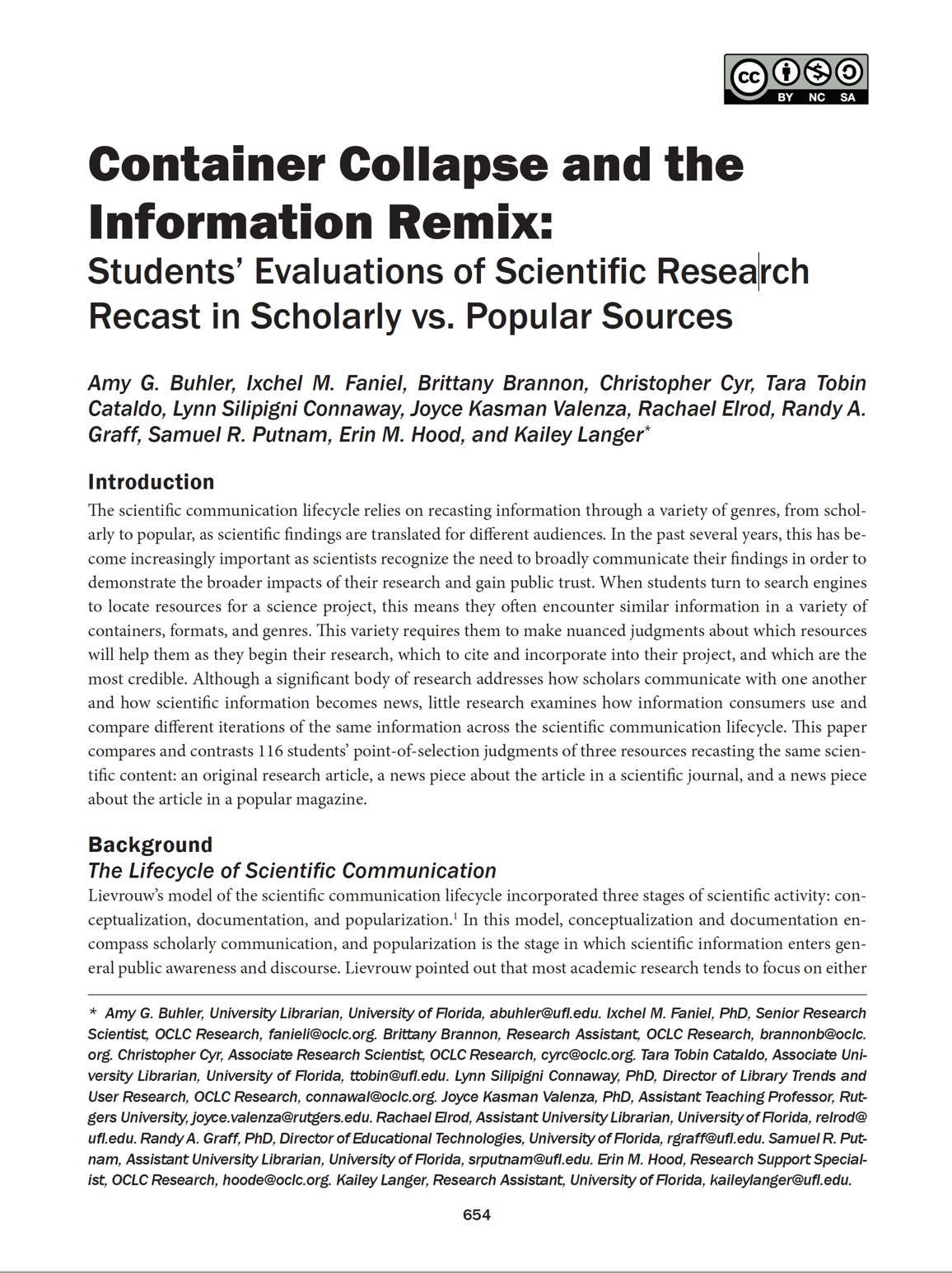Researching Students’ Information Choices:
Determining Identity and Judging Credibility in Digital Spaces
In the information overload of today’s digital world, determining the purpose, quality, and trustworthiness of resources is essential to finding good information. By studying how STEM students identify resource types and judge credibility in online spaces, this project will help to develop meaningful strategies for teaching the information literacy skills that will allow students to successfully navigate the ever-evolving online landscape.
Full project website (University of Florida)
Impact
- Study the online information-seeking behaviors of two under-studied groups:
- Late elementary and middle school students
- STEM students
- Determine whether students are format agnostic in online environments
- Inform practical, effective approaches to information literacy instruction
Details
For this research project, we consider whether students are format agnostic. First coined by Abram and Luther (2004), the term refers to students who either cannot or do not identify the container (i.e. document type) when making judgments relating to use of digital resources. Judging the container can be difficult in an online environment, however, given what the researchers call container collapse, meaning that the visual context and cues that print containers used to provide to help individuals identify documents’ origins are now obscured or are more difficult to discern. In digital format, a document is “decanted” from its original container and must be carefully examined to determine the journey it took to reach the individual.
Soules (2009) goes so far as to say “E-book, e-journal? Users don’t care; in fact they never cared, and many only understood book vs. journal in the print world because of the difference in their physical structures. What they want is relevant content” (pg. S4). But how do students distinguish whether relevant digital content is also credible digital content?
There is limited published research on how late primary, secondary, community college, and undergraduate STEM students identify and determine credibility. We collected data from almost 180 STEM students from grade 4 through graduate school as they participated in a simulation. They selected resources for a hypothetical school assignment from search engine results, and judged the credibility and container of the resources.
The findings from these simulations can be used to help create better information literacy and digital literacy instruction, and improve students’ ability to effectively discover, access, and use online resources. New publications and presentations will be posted here and on the University of Florida site.
Outputs
Blog Posts & Trade Publications
Stop Source-Shaming: Acknowledge Wikipedia in the research process:
American Libraries | 1 September 2021
By Lynn Silipigni Connaway and Joyce Valenza
Connaway and Valenza share results showing that established professionals commonly start with Wikipedia to get their bearings on a topic before diving further into the literature.
What is “container collapse” and why should librarians and teachers care?
Blog post | 20 June 2018
By Lynn Silipigni Connaway
Connaway provides an update to the work being done as part of the study Researching Students’ Information Choices (RSIC): Determining Identity and Judging Credibility in Digital Spaces. She focuses on initial results and defining the concept of container collapse.
Posted on the OCLC Next Blog.
Find more project outputs on the University of Florida site.
Publications
-

Authority, Context and Containers: Student Perceptions and Judgments When Using Google for School Work
7 May 2019
Tara Tobin Cataldo, Kailey Langer, Amy G. Buhler, Samuel R. Putnam, Rachael Elrod, Ixchel M. Faniel, PhD, Lynn Silipigni Connaway, PhD, Christopher Cyr, PhD, Brittany Brannon, Joyce Kasman Valenza, PhD, Erin M. Hood, Randy A. Graff, PhD
What really happens when student researchers meet a Google results page? How do students determine the authority behind each result? News, blogs, journals, Wikipedia, websites, e-books--with the vast array of online content available, how do students differentiate between them? Better still, do they differentiate between them or are these format agnostic students stymied by container collapse? The Researching Students’ Information Choices (RSIC) project is answering these questions.
-

Container Collapse and the Information Remix: Students’ Evaluations of Scientific Research Recast in Scholarly vs. Popular Sources
10 April 2019
Amy G. Buhler, Ixchel M. Faniel, Brittany Brannon, Christopher Cyr, Tara Tobin Cataldo, Lynn Silipigni Connaway, Joyce Kasman Valenza, Rachael Elrod, Randy A. Graff, Samuel R. Putnam, Erin M. Hood, Kailey Langer
A scientific communication life cycle publishes results in a variety of containers, formats, and genres to reach diverse audiences. This paper examines 116 students’ selection of scholarly and popular scientific content to compare how consumers use resources across the communication life cycle.
Project Lead:
Amy Buhler, MSLS, Principal Investigator, University of Florida
Active Team Members
- Amy Buhler, MSLS, Principal Investigator, University of Florida
- Tara Tobin Cataldo, MLS, Co-Principal Investigator, University of Florida
- Ixchel M. Faniel, Ph.D., Co-Principal Investigator, OCLC
- Lynn Silipigni Connaway, Ph.D., Co-Principal Investigator, OCLC
- Brittany Brannon, M.A., Research Assistant, OCLC
- Samuel R. Putnam, MLS, University of Florida
Former Team Members
- Joyce Kasman Valenza, Ph.D., Co-Principal Investigator
- Randy Graff, Ph.D., Investigator
- Rachael Elrod, M.Ed., MSLS, Investigator
- Christopher Cyr, Ph.D., Investigator
- Erin M. Hood, M.L.I.S., Investigator
- Christine Towler, Research Assistant
- Robin Fowler, MSLIS, Program Assistant
- Summer Howland, Instructional Designer
- Shakiyl Kirlew, Research Assistant
- Kailey Langer, Research Assistant